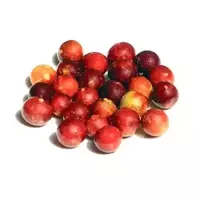Kama-kama

The low trees or shrubs of Myrciaria Dubia, which are native to the tropics of the Amazon lowlands in countries such as Colombia, Ecuador, Peru, Bolivia, and Brazil, produce camu camu fruits - a small size of red berries.
Kama-kama berries, which have a rather sour taste, are called nothing more than "natural vitamin capsules. " This distinctive property of kamu-kamu is due to the truly huge content of vitamin C, the amount of which is comparable only to the fruits of arase.
It is noteworthy that the medicinal properties of kamu-kamu have been known to humans for a long time - for many centuries berries have been used by South American Indians as a valuable source of food and an effective medicine. What is interesting: today kamu-kamu powder is popular and recognized by the Japanese, but at the same time it is practically not distributed in Europe and the USA.
Incredibly, it is a fact: the fruits of the Kama-Kama are still harvested by hand - exclusively by canoe it is possible to get to the swampy area of the Amazon basin, where this plant lives in natural conditions. In addition, the ripening time of the kama-kama falls just during the flood season, which is why you simply cannot do without using a canoe.
As you know, these berries do not take root in artificially created conditions, but they are still trying to grow them on low-lying plantations in Peru. The harvest of kama-kama occurs as the berries mature - so the maximum amount of ascorbic acid can be preserved in them. After removing the seeds, the berries are carefully dried at low temperature conditions, and then ground into powder.
Kama-kama composition
The composition of kamu-kamu is represented by the presence of various minerals, in particular, iron, phosphorus, potassium and calcium. There is a plant protein and leucine in these fruits - an amino acid synthesized only in humans. In addition, kamu-kamu contains serine or acid, which affects intercellular compounds, and thiamine is a vitamin that affects carbohydrate-fat metabolism.
The amino acid valine in kamu-kamu affects tissue formation, and ellagic acid is a compound whose role is important for the integral development of the human body. By the way, it is believed that it is able to resist the formation of cancer cells.
Kama-kama benefits
The benefits of kamu-kamu are the ability of these fetuses to strengthen the human immune system, improve blood composition and vision, protecting against glaucoma, cataracts and other eye diseases, and nourish the brain.
In addition, the property of the fruits, expressed in anti-inflammatory action, as well as the ability to get rid of migraines and headaches, also speaks in favor of kama-kama. It has been proven that substances in the composition of kamu-kamu prevent genetic mutations that are involved in the formation of malignant tumors.
kamu-kamu 28 kKal
Energy value of kamu-kamu (Ratio of proteins, fats, carbohydrates - ju):
Proteins: 1.55 g (~ 6 kCal)
Fats: 0.13 g (~ 1 kCal)
Carbohydrates: 4g (~ 16kCal)
Energy ratio (bj | y): 22% | 4% | 57%
 Español
Español Français
Français Português
Português Русский
Русский 简体中文
简体中文 繁體中文
繁體中文 日本語
日本語 한국어
한국어 العربية
العربية Türkçe
Türkçe Қазақ
Қазақ Deutsch
Deutsch Italiano
Italiano Українська
Українська
